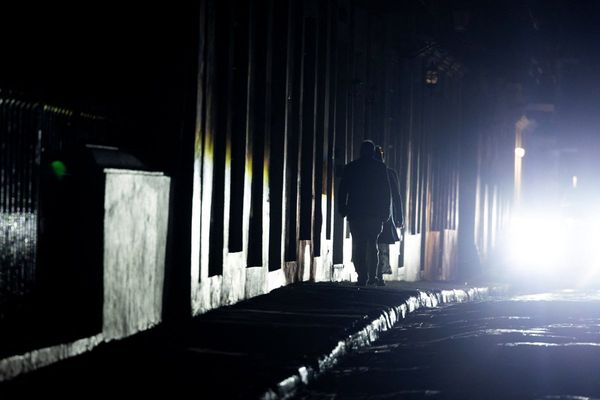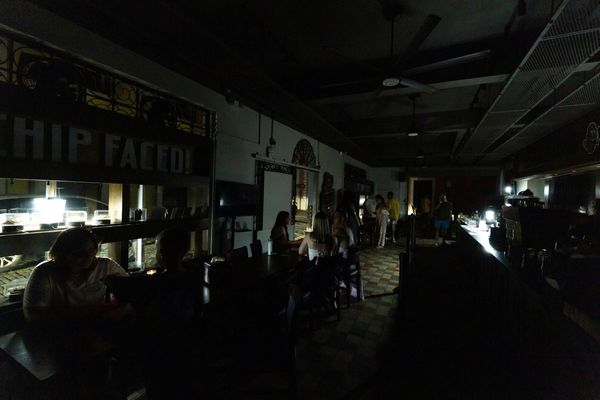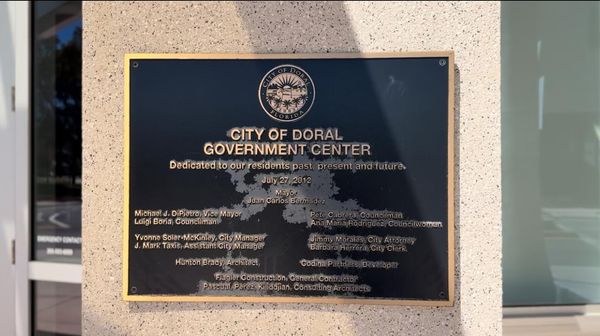
This series discusses the present and future of washoku traditional Japanese cuisine. This installment features sake.
What goes with sake? It's not just Japanese food. An approach expanding in contemporary gastronomy bases food and sake pairings on scientific knowledge explained using scientific terms, though that can be a mouthful.
In the Ebisu area of Tokyo, GEM by moto is causing a buzz for proposing unconventional food and sake pairings. The establishment's signature pairing is deep-fried ham cutlets with doburoku unfiltered, unrefined sake.
"The deliciousness just explodes," said Marie Chiba, the owner of the izakaya bar.
The bar makes the fried cutlet by sandwiching blue cheese and fermented black garlic between two thick slices of ham. It is served without Japanese-style Worcestershire sauce, a typical condiment for fried food in Japan. The salty ham and cheese with the crunchy breaded coating are enhanced by the unrefined sake's richly sour-sweet taste.
"I created this pairing as the sake takes the place of the sauce," Chiba said.
Her bar serves about 30 Western-style and Japanese-style dishes, as well as 200 types of sake from brewers across the nation.
The pairing of food and sake has been gaining attention in recent years.
"It used to be thought that sake should support dishes," Chiba said. "However, food and sake pairings can help enhance each other's flavor."
Chiba became interested in food and sake pairings about a decade ago. She had an eye-opening experience with aged sake, which she had disliked, when it was served with a dish of figs and raw ham topped with sesame sauce.
This experience prompted her to learn more at the National Research Institute of Brewing and other places. In her university days, Chiba studied food materials science and engineering.
Chiba can thus explain why some pairings of sake and food work well based on scientific facts. When distinguishing fruity flavors in sake, some arise from a component called ethyl caproate, which smells like apples, while isoamyl acetate smells like bananas. As the chemical terminology is universal, Chiba said it is also helpful for her when thinking of pairings.
"I hope that many people will experience the scrumptious delight" that comes from food and sake pairings, she added.
Chiba coauthored a book on food and sake pairing last year with Hitoshi Utsunomiya, a director at the Japan Sake and Shochu Makers Association.
"Young brewers don't hang on to conventional ideas, instead paying attention to aromas and acidity in producing sake with distinctive characteristics," Utsunomiya said. "This move also has been broadening the possibilities of pairings."
According to the book, basic rules are to pair food and sake that have similar characteristics, such as those with rich flavors, or contrasting characteristics, such as bitter and sweet. Moreover, the book proposes choosing sake that can give a finishing touch to a dish. For example, filtered but cloudy nigori-zake can be paired with deep-fried oysters to work like a sauce.
Another suggested rule is pairings based on similar fruity or herbal flavor profiles. For example, sake that is rich in citric acid or malic acid can be served with any fruit that fits each type, such as oranges or apples, respectively.
In contemporary gastronomy across the world, there are a lot of experiments with molecular cooking and molecular pairing. These analyses of food and beverage materials at the molecular level can be applied to sake, too, Utsunomiya said.
"Sake will face challenges of how to deal with diversifying diets," he added. "We have high hopes for the possibilities of pairing sake with various dishes from around the world."
Academia follows suit
Sake has become an area of study at universities across multiple fields.
The Japan Research Association for Sakeology was founded in the spring of 2019 by about 20 people, mostly professors from across Japan. It aims to integrate studies that have been separately conducted on sake in various fields -- including zymurgy, fermentation technology, the humanities and social science -- into one field named "sakeology."
"This is like studying sake from all directions, just like a volcanic caldera lake encircled by the outer rim," said Akira Sawamura, a professor in the Faculty of Economics at Niigata University, who is in charge of the organization's main office.
The university set up the Sakeology Center in 2018 in cooperation with the Niigata prefectural government and the Niigata Sake Brewers Association.
The center has about 50 teachers from the university's 10 faculties as members who conduct research and give lectures on various themes, from the history of sake making and the culture of hanamachi geisha districts to the relations between alcohol and the brain.
The center will also conduct joint research with the University of Bordeaux in France.
"Studies and knowledge of wine have been widely accepted as a social asset in Western countries," said Hitoshi Takahashi, head of the Sakeology Center. "We aim to develop sakeology in a similar way."
Read more from The Japan News at https://japannews.yomiuri.co.jp/







